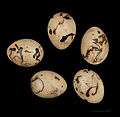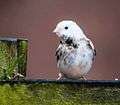Common reed bunting
| Common reed bunting | |
|---|---|
_m.jpg) | |
| Male | |
_f.jpg) | |
| Female – Both at Otmoor, Oxfordshire Male bird recorded in Norfolk, England | |
| Scientific classification | |
| Kingdom: | Animalia |
| Phylum: | Chordata |
| Class: | Aves |
| Order: | Passeriformes |
| Family: | Emberizidae |
| Genus: | Emberiza |
| Species: | E. schoeniclus |
| Binomial name | |
| Emberiza schoeniclus (Linnaeus, 1758) | |
The common reed bunting (Emberiza schoeniclus) is a passerine bird in the bunting family Emberizidae, a group now separated by most modern authors from the finches, Fringillidae. The genus name Emberiza is from Old German Embritz, a bunting. The specific schoeniclus is from Ancient Greek skhoiniklos, a now unknown waterside bird.[2]
It breeds across Europe and much of temperate and northern Asia. Most birds migrate south in winter, but those in the milder south and west of the range are resident. It is common in reedbeds and also breeds in drier open areas such as moorland and cultivation. For example, it is a component of the purple moor grass and rush pastures, a type of Biodiversity Action Plan habitat in the UK. It occurs on poorly drained neutral and acidic soils of the lowlands and upland fringe. It is found in the South West of England, especially in Devon.
The familiar, monotonous, song of the cock is a repetitive zrip.
Description
The common reed bunting is a medium-sized bird, 13.5–15.5 cm long, with a small but sturdy seed-eater's bill. The male has a black head and throat, white neck collar and underparts, and a heavily streaked brown back. The female is much duller, with a streaked brown head, and is more streaked below.
Food and feeding
Its natural food consists of insects when feeding young, and otherwise seeds. The nest is in a bush or reed tussock. 4–7 eggs are laid, which show the hair-like markings characteristic of those of buntings.
Gallery
 A male in winter in England
A male in winter in England In natural shore habitat
In natural shore habitat Female
Female ID composite
ID composite Eggs MHNT
Eggs MHNT Chirp
Chirp Leucistic reed bunting
Leucistic reed bunting
References
- ↑ BirdLife International (2012). "Emberiza schoeniclus". IUCN Red List of Threatened Species. Version 2013.2. International Union for Conservation of Nature. Retrieved 26 November 2013.
- ↑ Jobling, James A. (2010). The Helm Dictionary of Scientific Bird Names. London, United Kingdom: Christopher Helm. pp. 145, 350. ISBN 978-1-4081-2501-4.
External links
| Wikimedia Commons has media related to Emberiza schoeniclus. |
- Emberiza schoeniclus : songs, sonagrams
- ARKive Stills, Video
- Ageing and sexing (PDF; 3.7 MB) by Javier Blasco-Zumeta and Gerd-Michael Heinze
- Feathers of common reed bunting (Emberiza schoeniclus)
